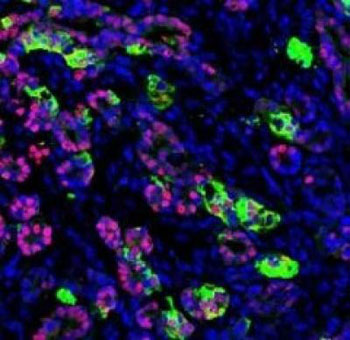Reprogrammed Skin Cells Produce Insulin and Prevent Diabetes in Mouse Model
By LabMedica International staff writers
Posted on 17 Jan 2016
Advances in chemical and genetic methods for cellular reprogramming have enabled researchers to convert human skin cells (fibroblasts) into fully functional pancreatic beta cells.Posted on 17 Jan 2016
Investigators at the University of California, San Francisco (USA) began by nudging human fibroblasts towards an endodermal cell fate by employing non-integrative episomal reprogramming factors in combination with specific growth factors and chemical compounds. On initial culture, converted definitive endodermal progenitor cells (cDE cells) were channeled into becoming posterior foregut-like progenitor cells (cPF cells). The cPF cells and their derivatives, pancreatic endodermal progenitor cells (cPE cells), were then greatly expanded (by more than a trillion-fold) in mass culture.

Image: Micrograph of functioning human pancreatic cells following transplantation into a mouse (Photo courtesy of Dr. Saiyong Zhu, University of California, San Francisco).
A screening approach enabled the investigators to identify chemical compounds that promoted the differentiation and maturation of cPE cells into functional pancreatic beta-like cells (cPB cells) in vitro.
Populations of cPB cells were transplanted into mice, and the investigators reported in the January 6, 2016, online edition of the journal Nature Communications that these cells exhibited glucose-stimulated insulin secretion in vivo and protected the mice from chemically induced diabetes.
The results obtained during this study have important implications for future strategies aimed at generating high numbers of functional beta cells, which may help restoring glucose balance in patients suffering from diabetes.
Senior author Dr. Sheng Ding, professor of pharmaceutical chemistry at the University of California, San Francisco, said, "This new cellular reprogramming and expansion paradigm is more sustainable and scalable than previous methods. Using this approach, cell production can be massively increased while maintaining quality control at multiple steps. This development ensures much greater regulation in the manufacturing process of new cells. Now we can generate virtually unlimited numbers of patient-matched insulin-producing pancreatic cells."
Related Links:
University of California, San Francisco










 (3) (1).png)


